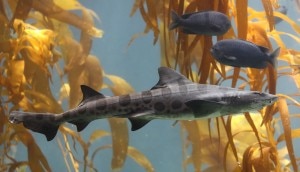Fish Identification: Leopard Shark
For the first time in our fish identification series, we're going to look at a sea creature that's not actually a fish. I think leopard sharks are awesome, and hope to come across one in a dive someday.
Physical description
[ ][]
][]
I assume most people can tell a shark when they see one, so I'll focus
on the features that make leopard sharks unique. Clearly the first
distinguishing feature is the source of their name. Leopard sharks have
long, slender bodies covered in dark ink stain-looking spots. Their
underbelly is all white.
They have two dorsal fins. The first is about halfway along its back and the second fin, almost the same size, is close to to the caudal (tail) fin. Leopard sharks also have an anal fin on their rear underbelly. Their caudal fins have a long upper lobe which extends out much further than the lower lobe. The forward dorsal fin and pectoral fins give them their tell-tale "sharky" look.
Leopard sharks have mouths on the bottom of their heads, probably for easy consumption of bottom-dwelling food like crabs and clams. They grow to lengths of 1.2 - 1.5 m (3.9 - 4.9 ft).
Geography and habitat
The leopard shark is found along the Pacific coast of North America, as far north as Oregon all the way down to Mexico. They like muddy or flat ocean bottoms in relatively shallow water (5 m / 15 ft).
They are often found in bays or estuaries, although there have been plenty of sightings in kelp beds and rocky reefs. They usually are found relatively dormant on the ocean bottom. They are harmless to humans, but don't go harassing them.
Overfishing
Leopard shark populations were rapidly declining during the 80s due to overfishing for food and aquariums. However, regulations introduced in the 90s brought them back up to a sustainable amount. Even though I don't like the aquarium trade, it is reassuring to see regulations in place that protect threatened species through compromise and sustainable practices.
Further reading
[ ]: http://thedivingblog.com/uploads/2010/03/leopard_shark.jpg
]: http://thedivingblog.com/uploads/2010/03/leopard_shark.jpg
